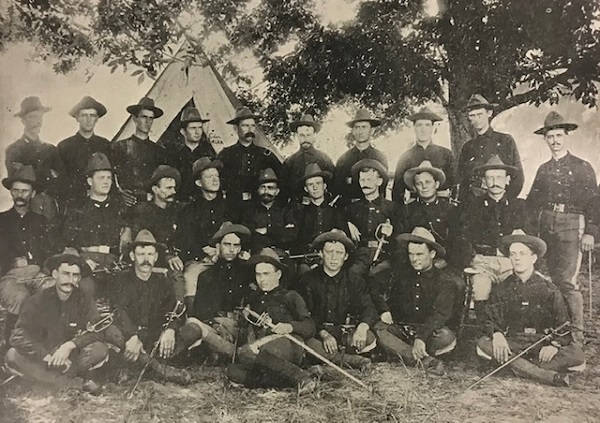


The Second Alabama Volunteer Infantry served its term of service within the continental U.S. during the Spanish American War.
Unit History:
The Second Alabama Volunteer Infantry was mustered into service between May 16 and June 14, 1898 at Mobile, Alabama. At the time of mustering in, the regiment consisted of forty-seven officers and 935 enlisted men under the command of Col. James W. Cox.
The companies were as follows:
Company A, Montgomery Grays ( Montgomery)
Company B, Lomax Rifles (Mobile)
Company C, Mobile Rifle Company (Mobile)
Company D, Montgomery True Blues (Montgomery)
Company E, Gulf City Guards (Mobile)
Company F, Warrior Guards (Tuscaloosa)
Company G, Eufaula Rifles (Eufaula)
Company H, Troy Rifles (Tory)
Company I, Jackson County Volunteers
Company K, Vaiden's Rough Walkers
Company L, Phoenix City Rifles
Company M, Mobile Cadets (Mobile)
While in camp at Mobile, the young ladies of the city presented the regiment with its regimental colors. The women of the city donated instruments for the regimental band. However, conditions in Mobile soon soured. It was reported that yellow fever was present in the camp. Also, at one point four hundered men from three regiments, including the Second Alabama, failed to show for roll call a day after being paid and obtaining alcohol.
Initially assigned to the Fourth Army Corps at Mobile, the regiment was reassigned to the Second Brigade, First Division of Maj. Gen. Fitzhugh Lee’s Seventh Army Corps and sent to Miami. While the regiment was forming, its commander was presented with a legal issue. A warrant was received for Frank Kilpatrick of Company F, who was being charged with murder in Pickens County, Alabama. Cox refused to turn Kilpatrick over since he was mustered into the federal service before the warrant was issued.
On June 30, the regiment arrived at Miami, Florida, where it remained until August 4, 1898. While the regiment was in Miami, Santiago, Cuba fell to American forces on July 17, 1898. On August 5, it arrived at Jacksonville, Florida’s Camp Cuba Libre, While the regiment was at Jacksonville, an armistice was reached with Spain, ending the war’s fighting.
In September, the regiment was ordered to Montgomery, Alabama, arriving on September 17. At Montgomery, the regiment was give a thirty-day furlough beginning September 20 . On October 31, the Second Alabama Volunteer Infantry was mustered out of service at Birmingham, Alabama. At the time of mustering out, the regiment had forty-nine offices and 935 enlisted men. The war ended on December 10, 1898 with the signing of the Treaty of Paris.
During its term of service, the regiment lost fifteen enlisted men to disease, two men to accidents and one man drowned. In addition, thirty-five men were discharged on disability and fifty-four men deserted.
Alabama Volunteers in the Spanish American War. (Alabama Adjutant Generals Office, 1899) 13-25
"Are Reugl ars Sure," The San Antonio Light. (San Antonio, Texas), June 24, 1898, 4 (drunkiness in Mobile).
"As to a Third Call," Davenport Daily Leader. (Davenport, Iowa) June 21, 1898, 1 (Concerning initial assignment to 4th Army Corps).
"Camp Coppinger," The San Antonio Light. (San Antonio, Texas), June 19, 1898 (yellow fever in Mobile).
Correspondence relating to the War with Spain And Conditions Growing Out of the Same Including the Insurrection in the Philippine Island and the China Relief Expedition. Vol. 1 (Washington: Government Printing Office, 1902) 583.
“Mobile Camp Notes,” Galveston Daily News. (Galveston, Texas) May 29, 1898 (info. on Frank Kilpatrick)
“Soldiers on a Jamboree,” Galveston Daily News. (Galveston, Texas) June 25, 1898 (info. on flag and instrument presentation)
Statistical Exhibit of Strength of Volunteer Forces Called into Service During the War with Spain; with Losses from All Causes. (Washington: Government Printing Office, 1899).